
Fig. 1. Process flow diagram showing
soil separation and treatment via SGS/CVL.
Mark Cummings and Steven R. Booth
Environmental
Technology Cost-Savings Analysis Project (ETCAP)
Energy and Environmental
Analysis Group
Technology and Safety Assessment Division
Los Alamos
National Laboratory
ABSTRACT
An innovative, two-stage process for the remediation of uranium-contaminated soils was successfully demonstrated at Los Alamos National Laboratory's (LANL) Technical Area 33 (TA-33). The first step in the treatment process reduced the volume of the contaminated soil using the Thermo Nuclean (a division of the Thermo NUtech company) Segmented Gate System (SGS). This technique applies the use of radiation detectors to separate clean soil from contaminated soil as it moves along a conveyor belt. Contaminated soil is diverted to a separate storage bin toawait further processing, while uncontaminated soil is returned to its original location. From the 218 cubic yards of soil excavated from the test site at TA-33, only 7 cubic yards were found to contain uranium contamination above the criterion release limit, yielding an initial waste volume reduction of 97%.
The second step in the remediation was removal of the uranium from the 7 cubic yards of remaining soil using the containerized vat leaching (CVL) process developed at LANL. Borrowing techniques from the mining industry, the uranium was solubilized and collected in solution. Once recovered in the liquid phase, the uranium was subsequently removed from solution using an ion exchange resin. Thus, by applying the combined SGS/CVL processes, the total volume of radioactive waste at TA-33 was reduced from 218 cubic yards of contaminated soil to approximately 30 gallons of leachate solution and resins. In addition, the recovered commercial-grade uranium may be resold to recover some of the costs of operation. The current price of uranium is $14.80/lb (1).
A cost effectiveness analysis was performed comparing the above two-stage treatment process to conventional excavation, containerization, and internment (dig and haul). Results showed that while the cost of remediating the small volume of soil at TA-33 was slightly more expensive than using the baseline treatment method, significant cost savings can be realized using SGS/CVL when treating greater volumes of soil, assuming that the contaminated soil must be shipped to a permitted facility such as Utah's Envirocare. However, if LANL's Area G is an acceptable alternative to the permanent disposal of low-level radioactive waste (LLRW), then there is little economic incentive to treating LANL waste via SGS/CVL because of the low cost of on site disposal, particularly for small volumes of soil. (Since the original release of this report in September 1996, LANL management has decided to no longer accept construction waste, demolition waste, or suspect soil at Area G due to limited capacity and uncertain lifetime of the disposal facility. This makes cost comparisons with onsite disposal at Area G less applicable at this time.)
INTRODUCTION
Because it is difficult to characterize heterogeneously contaminated soils in detail and to excavate such soils precisely using heavy equipment, it is common for large quantities of uncontaminated soil to be removed during excavation of contaminated sites. Until now, volume reduction of radioactively contaminated soil depended upon manual screening and analysis of samples, a costly and impractical approach, particularly with large volumes of heterogeneously contaminated soil. The baseline approach for the remediation of soils containing radioactive waste is excavation, pretreatment, containerization, and disposal (i.e., dig and haul) at a federally permitted landfill. However, disposal of LLRW is expensive and storage capacity is limited. Thermo Nuclean's Segmented Gate System (SGS) removes only the radioactively contaminated soil, in turn greatly reducing the volume of soil requiring treatment or disposal. The fraction of contaminated soil that remains after processing with SGS is treatable via the containerized vat leaching (CVL) system developed at LANL. Uranium is leached out of the soil in solution. The uranium is recovered with an ion exchange resin, leaving only a small volume of very low-level liquid secondary waste requiring disposal. The reclaimed soil can be returned to its original location after treatment with CVL. A process flow diagram for the two-stage treatment train is shown in Fig. 1.

Fig. 1. Process flow diagram showing
soil separation and treatment via SGS/CVL.
POTENTIAL COST SAVINGS ACROSS DOE COMPLEX
The total volume of soil contaminated by radioactive waste across the DOE complex has yet to be accurately quantified; however, DOE's Baseline Environmental Management Report (BEMR) estimates that soil volumes in the millions of cubic yards will require treatment and disposal for radioactive and/or hazardous waste (2). SGS/CVL has the potential to save in excess of $45 million for remediation of each 100,000 cubic yards of radioactively contaminated soil, a cost savings of approximately 75% over conventional technology.
SITE DESCRIPTION AND CLEANUP GOALS
TA-33 at LANL was selected as a suitable pilot test site for demonstrating the effectiveness of the SGS/CVL processes because it is well-characterized and contained, and uranium is the only contaminant. The uranium contamination was the result of ballistics tests performed during the late 1940s. Uranium slugs were fired from a cannon into a catch box mounted in a hillside. Subsequent excavation of the soil revealed 56 uranium slugs, only 2 of which were completely oxidized. The heterogeneous nature of the contamination indicated that volume reduction based on separation of radioactive from clean soil would be an advantageous and practical first step in the remediation. The soil itself is a dry (9.8% moisture content), neutral, homogenous mix of predominantly sand and gravel with minor amounts of silt (9.3%) and clay (6.0%). Background levels of approximately 3 picoCuries per gram (pCi/g) gamma activity have been established in the vicinity of the test site. DOE's established cleanup level for uranium-contaminated soil based on the RESRAD model for unrestricted use is 112 pCi/g (3). Subsequent analyses from Thermo Nuclean showed an average of 104 pCi/g gamma activity from the diverted soil, and an average of 11 pCi/g from the "clean" soil (4).
TECHNOLOGY DESCRIPTION
Segmented Gate System
The contaminated soil is excavated via front-end loader and emptied into a hopper as shown in Fig. 2. There the soil is introduced to a hammermill to break up chunks and rocks, and then screened so that soil particles are relatively uniform in size. The soil is transported via conveyor belt underneath two banks of sodium iodide scintillation detectors which transmit data to a host computer that evaluates the amount of contamination in the soil. The detectors measure a minimum activity of approximately 30 pCi/g. The computer controls the operation of mechanical gates that direct small streams of soil to separate paths depending on the amount of radioactivity present. Contaminated soil is collected and containerized for further processing while clean soil is collected for return to its original location. Cumulative records are kept on a daily basis of total soil mass and radioactivity for both contaminated and uncontaminated soils.
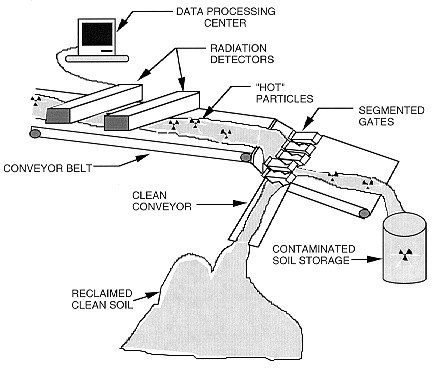
Fig. 2. The segmented gate system
diverts clean soil from radioactively contaminated soil (4).
At Johnston Atoll, a military base in the South Pacific, SGS was demonstrated to successfully process over 55,000 tons of plutonium-contaminated soil, achieving a volume reduction of greater than 98% (5). At DOE's Savannah River Site 800 tons of soil were processed by SGS with a volume reduction of 99% for Cs-137. At the pilot test site at LANL's TA-33, a volume reduction of approximately 97% was achieved. In all cases, the uncontaminated portion of the soil was returned to its original location, significantly reducing the volume of soil requiring disposal.
Containerized Vat Leaching
Radioactive soil is contained in three one-cubic yard vats hung from a metal frame and suspended over a catch basin as shown in Fig. 3. An overhead sprinkler system sprays sodium bicarbonate solution onto the soil from above. The leachate passes through the vats, solubilizing the uranium and releasing it as uranyl carbonate. Once recovered in liquid form, the complexed uranium is subsequently removed from solution using an ion exchange resin while the leachate is recycled through the system. This method has been successfully used by the mining industry to extract uranium metal from low-grade ores. In addition to uranium, the leaching method has been shown to be effective at extracting other radioactive isotopes and hazardous metals; e.g., plutonium, lead, and beryllium (6).
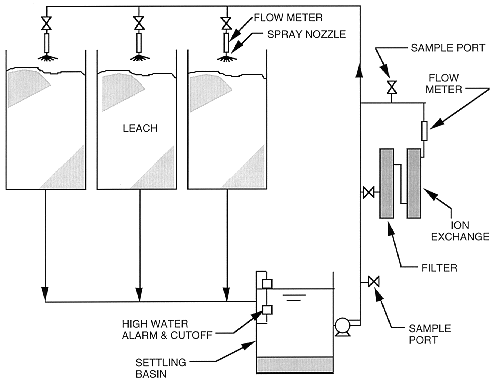
Fig. 3. Simplified schematic of the
containerized vat leaching system (6).
RESULTS OF TA-33 PILOT TEST
A total of 218 cubic yards of uranium-contaminated soil was processed at the test site using SGS. Soil segregation took place over several days; however, the total processing time amounted to only 15.8 hours. Only 7 cubic yards showed activity levels above the sensitivity of the sodium iodide detectors, yielding an initial volume reduction of 97%. The detail behind the amounts of soil processed on a daily basis throughout the duration of the pilot test, and the activity counts for both diverted and "clean" soil are shown in Table I. Treatment via CVL removed 97% of the uranium from the diverted soil. The total fraction removed required approximately 21 days to leach through the system, but greater than 80% of the uranium contamination was removed in the first seven days. All of the diverted soil was subsequently returned to its original location.
COST COMPARISON WITH BASELINE TECHNOLOGY
Segmented Gate System
SGS operational unit costs depend on the volume of soil processed, and range from approximately $320/cubic yard based on the 218 cubic yard volume at TA-33, to about $50/cubic yard based on a projected volume of 40,000 cubic yards (4). As a result, total processing costs increase as soil volumes increase, but the unit costs for remediating larger volumes of soil drop dramatically, yielding greater cost savings with increasing soil volumes. Operational unit costs do not include the cost for mobilization/demobilization of the SGS equipment, an additional cost of approximately $70,000 to $100,000, depending on the size of the project. Also not included in SGS processing are the costs for soil excavation. (Soil screening is an integral part of SGS processing costs.) Excavation costs at TA-33 were based on an hourly rate for a loader and operator and amounted to approximately $2,000 for the project (7).
For the demo at TA-33, the addition of the mob/demob costs (~ $70,000) amounted to a doubling of the operational unit cost (approximately $70,000 divided by 218 cubic yards = $320/cubic yard), so that the actual unit cost for the total project was closer to $640/cubic yard. If mob/demob costs were to be included in cost estimates for 5,000 and 40,000 cubic yards, then the actual unit costs for these volumes of soil are approximately $69/cubic yard and $55/cubic yard, respectively (4).
Containerized Vat Leaching
A cost comparison of various technologies for removing uranium from soils performed by Oak Ridge National Laboratory (ORNL) (8) showed the containerized vat leaching process for uranium removal to be more cost effective than conventional soil washing, off-site landfilling, or the Tiron® process. The ORNL study, supported by the pilot test at TA-33, estimated order-of-magnitude unit costs for CVL to be about $250/cubic yard.
The total cost for CVL will depend upon the extent and homogeneity of contamination at the site. For example, SGS diverted 97% of the excavated soil at TA-33, so only 7 cubic yards required subsequent treatment by CVL. In this case, typical so far for these technologies, the cost for treatment via CVL was a small percentage of the total project cost. However, it is conceivable that a homogenously contaminated site might only yield an initial soil volume reduction of 10% or 20%. Costs for CVL treatment would then become more significant in terms of total project cost.
Table I SGS Site Data Shows a Total of 218.63 Cubic Yards Processed Over a
Period of 9 Days. The Diverted Soil Contained Approximately 104 pCi/g
Radioactivity, Below the RESRAD Cleanup Level of 112 pCi/g Even Before Treatment
via CVL (4).
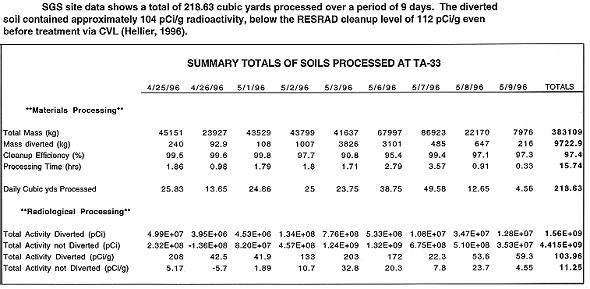
Dig and Haul
The baseline approach for the remediation of soils containing radioactive and/or hazardous waste is excavation, pretreatment, containerization, and disposal (i.e., dig and haul) at a federally permitted landfill. A conservative estimate for excavation and screening of radioactively contaminated soil at $100/cubic yard is assumed to apply. Costs for disposal of soils containing LLRW at an appropriate facility such as Envirocare run about $225/cubic yard. Transportation costs to Envirocare for LLRW are approximately $300/cubic yard (9). However, LANL offers the option of storing its own LLRW at Area G for only $2/cubic foot, or $54/cubic yard. Transportation costs within LANL boundaries amount to approximately $25/cubic yard for the volume of soil at TA-33 (7). Using these estimates, Figure 4 compares the total cost for disposal of the 218 cubic yards of soil from TA-33 at Envirocare and at LANL's Area G, versus the cost of volume reduction and treatment via SGS/CVL. The same costs are then compared in Figure 4 for remediation of 5,000 cubic yards of soil.
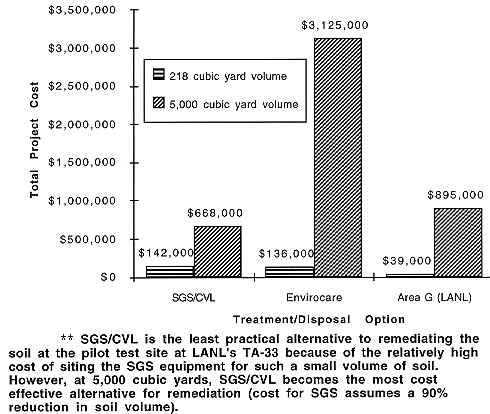
Fig. 4. SGS/CVL is the least
practical alternative to remediating the soil at the pilot test site at LANL's
TA-33 because of the relatively high cost of siting the SGS equipment for such a
small volume of soil. However, at 5,000 cubic yards, SGS/CVL becomes the most
cost effective alternative for remediation (cost for SGS assumes a 90% reduction
in soil volume).
Two important conclusions can be drawn from Fig. 4. First, the availability of onsite disposal greatly skews the cost comparison between SGS/CVL and dig and haul. Decisions concerning the fate of radioactively contaminated soil based solely on economics favor onsite disposal, especially for small volumes of soil. Second, if onsite disposal is not an option, then costs for treatment via SGS/CVL vs. offsite disposal are similar, even for the small volume of soil at the test site.
The breakeven point for cost effectiveness using SGS/CVL probably lies somewhere between 250 and 500 cubic yards, assuming the same percentage of initial volume reduction. As a rough example, suppose the volume at TA-33 were doubled to 436 cubic yards, but that the operational unit costs and mob/demob costs for SGS/CVL remained the same. Then the total project would cost $320/cubic yard x 436 cubic yards, plus $70,000 for mob/demob, plus excavation for SGS, plus $250/cubic yard x 14 cubic yards for CVL treatment, plus secondary waste disposal costs for CVL = about $220,000. Excavation, screening, containment, transportation, and disposal at Envirocare would amount to $625/cubic yard x 436 cubic yards = $270,000. So SGS/CVL would be more economical in this scenario, even assuming no reduction in operational unit costs for the doubling of soil volume.
An additional hidden cost with dig and haul concerns the concept of "perpetual management." Long after the contaminated soil has been disposed of, there remains ongoing life-cycle management of the disposal facility, which is subject to political pressures, land use issues, and other nebulous circumstances. Therefore, waste volume reduction and treatment is most likely the preferred option if costs are even close to dig and haul.
To compare how cost savings may apply with even greater volumes of soil, Table II compares the costs of using SGS/CVL vs. dig and haul for the processing of 100,000 cubic yards of uranium-contaminated soil. For this comparison, two initial soil volume reductions via SGS are assumed: a conservative figure of 80%, and a more realistic figure of 95%, based on current experience. Area G at LANL does not have the capacity to store soil volumes of this magnitude, so for comparison to dig and haul in this scenario, it is assumed that contaminated soil would need to be shipped to Envirocare. The $700/cubic yard unit cost given for disposal under SGS/CVL in Table II presumes that some (albeit small) secondary waste stream is generated by CVL, and that the secondary waste stream is in the form of resins and leachate that would require pretreatment in the form of stabilization/solidification. This adds approximately $175/cubic yard to the basic cost of transportation and disposal. Table II shows how cost savings using SGS/CVL could amount to $45 to $50 million based on the unit costs for processing 100,000 cubic yards of soil, depending on the initial volume reduction achieved by SGS.
Table II Potential Cost Savings Using SGS/CVL to Clean 100,000
Cubic Yards of Radioactively Contaminated Soil
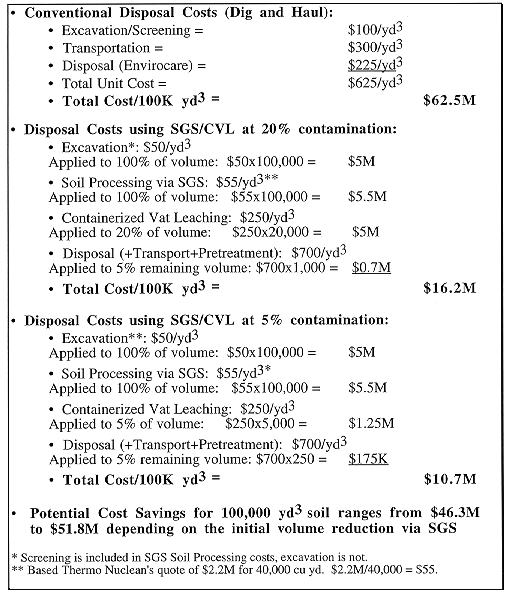
Not shown in Table II is the comparison cost of using just SGS alone with no subsequent treatment for the extraction of remaining uranium. At 80% soil volume reduction from an initial 100,000 cubic yards, 20,000 cubic yards would need to be landfilled at Envirocare at a cost of $525/cubic yard (transportation + disposal), or $10.5M, as compared to $5.7M for treatment using CVL. At 95% reduction via SGS, only 5,000 cubic yards would require transportation and disposal, at a cost of $2.6M, compared to $1.42M using CVL. Either way, it is more economical to include CVL treatment than apply SGS and disposal alone, unless the option remains of storing low-level radioactive soil onsite.
CONCLUSIONS
AREAS FOR FURTHER RESEARCH
Los Alamos National Laboratory is proposing to demonstrate the SGS/CVL technologies for the remediation of mixed waste. With the addition of laser-induced breakdown spectroscopy (LIBS) metals detectors (another technology developed at LANL), the SGS system would have the capability to segregate metals-contaminated as well as radioactively-contaminated soil. The proposed technology demonstration will take place at LANL's R-44 firing site, an area heavily contaminated with uranium, lead, and beryllium. As costs for disposal of mixed waste are much higher than for low-level radioactive waste, even greater cost savings can be expected for remediation of mixed waste using SGS/CVL.
Thermo Nuclean is currently developing an SGS Junior. This is a scaled-down version of the unit used at TA-33, and would be applicable for smaller sites. The SGS Junior would require considerably less mob/demob time and expense, thus making it more easily transportable and cost effective for cleaning up small plumes or "hot spots" at larger areas.
ACKNOWLEDGMENTS
The authors would like to thank Chuck Hellier and Scott Rogers from Thermo Nuclean for their cooperation and assistance in providing information and cost estimates for the Segmented Gate System technology. Thanks also to Billy Turney and Cass Mason at Los Alamos National Laboratory for their enthusiasm and willingness to share their work on the Containerized Vat Leaching technique, and to Roy Michelotti for his valuable insight and feedback on this report.
REFERENCES
*LA-UR-96-2663